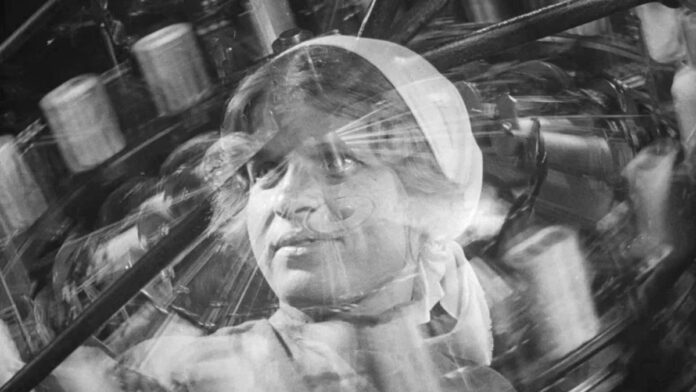This is a guest post for Silent London by film historian Richard Bossons about the reconstruction of the original score for Man With a Movie Camera. The new Eye Filmmuseum print of the film will screen at the Rainy Days contemporary music festival at the Philharmonie in Luxembourg on 23 November with an ensemble from the Luxembourg Philharmonic conducted by Leo Geyer, playing this reconstructed score.
The original music for the 1929 Moscow screening of the film has been recreated by the composer Leo Geyer and myself Richard Bossons.
Though a silent film, the visual rhythm of Dziga Vertov’s Man with a Movie Camera is often akin to a musical composition. Vertov’s biographer John MacKay suggested that he used the frames of the film and the intervals between them in a similar way to notes on a score. The film is structured so that its tempo gradually increases to reach an extraordinary climax at the end, a thrilling montage of chaotic images created by the film’s editor, Elizaveta Svilova. The Soviet film scholar Yuri Tsivian wrote that “Man with a Movie Camera invades the territory of sound cinema as far as a silent film can reach.”
Some film historians, and even Svilova herself, have claimed that Vertov intended his film to be watched in silence. The evidence suggests that this is incorrect. From a letter written by him shortly before the Moscow premiere of his film, it seems that the Ukrainian producers of Man with a Movie Camera, VUFKU, had failed to provide an accompaniment and Vertov himself had to organise one in only a few days with the help of three musicians, two of whom were well-known cinema orchestra conductors.
In 1995 Professor Tsivian published, in Griffithiana No. 54 (October), his translation of two documents that he discovered the previous year in the Vertov archive in the Russian State Archive of Literature and Art, Moscow. Document 1 consists of handwritten notes by Dziga Vertov of a ‘Music Scenario’ describing the type of music and sounds he thought appropriate for each film sequence. The second document comprises typewritten cue notes for cinema orchestras loosely based on Vertov’s notes.

The state film organisation Sovkino approved this ‘Musical Conspectus’ a week before the screening of the film in Moscow so it was clearly intended for the orchestras in the two cinemas used for the premiere on 9 April 1929, and during the week the film was shown in the city. One of the compilers of the cue notes was a conductor at the Hermitage cinema.
The ‘Musical Conspectus’ consists of recommendations for excerpts from mostly late 19th– and early 20th-century compositions with exact timings and ‘mood’ suggestions for the film sequences. These cue notes, common during the silent film period, would have been used by the cinema orchestra conductors to arrange each excerpt to suit the sequence. Despite the traditional choice of music, and the haste with which the cue notes were compiled, the suggested excerpts generally work well with this experimental film. Most of the composers of mainly ballet music and overtures are still familiar, but several are little known today and extensive research was needed to find their suggested pieces. This may be the first time in decades that music by Isaac Snoek, Giulio de Micheli, and Édouard Trémisot will be heard.

In many cases the suggested music was longer than the related film sequence, so some judgement was necessary to select an appropriate excerpt. Some of the compositions were too short and additional music had to be composed in the style of the original. All the music needed arranging to suit the exact timing of the film sequences and the orchestration (based on the small orchestra seen at the beginning of the film). This interpretation of the Conspectus is therefore as close as possible to what might have been heard by the audiences at the Moscow screenings given that there is no record of the particular excerpts from the suggested music that were played or how they were orchestrated.
There have been many attempts to provide a score for Man with a Movie Camera but this is the only one based on a documented contemporary accompaniment to the film. The recreated music has been synchronised with a new print by Eye Filmmuseum, Amsterdam, based on Vertov’s own nitrate copy acquired by the Filmliga film club in the city during his 1931 tour of Europe. The full-frame print reinstates all the rising and falling part numbers, and is less digitally processed than other recent restorations, making it much closer to the 1929 version of the film.
By Richard Bossons



